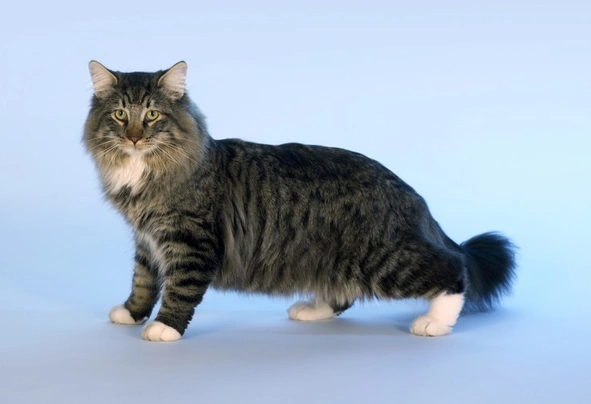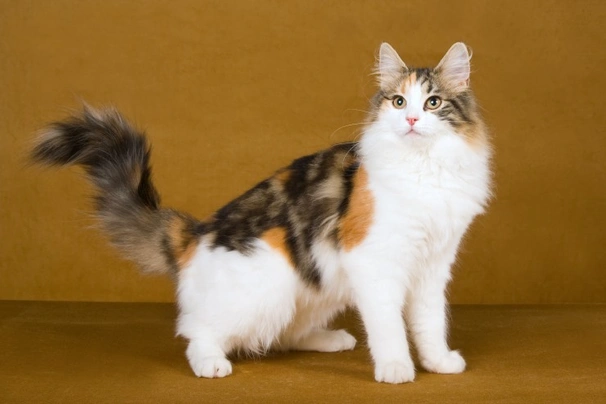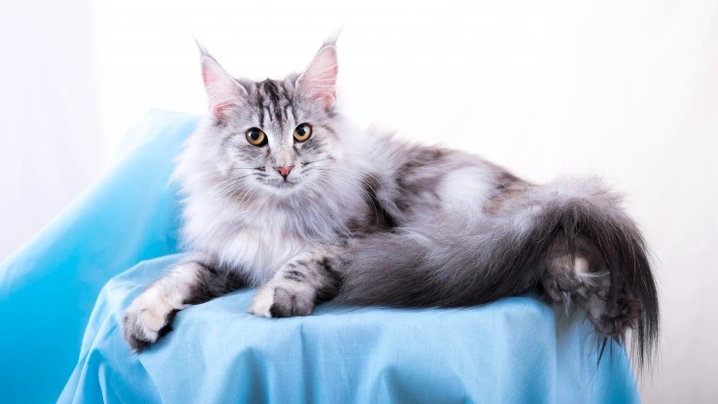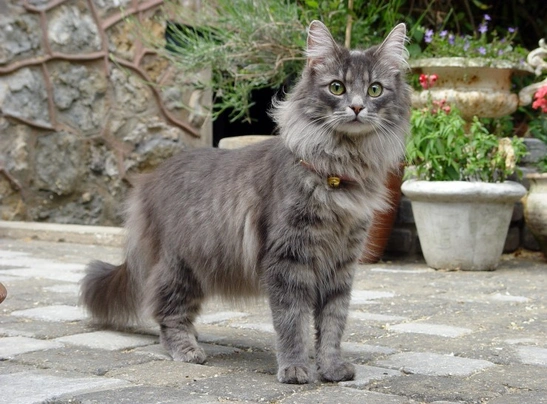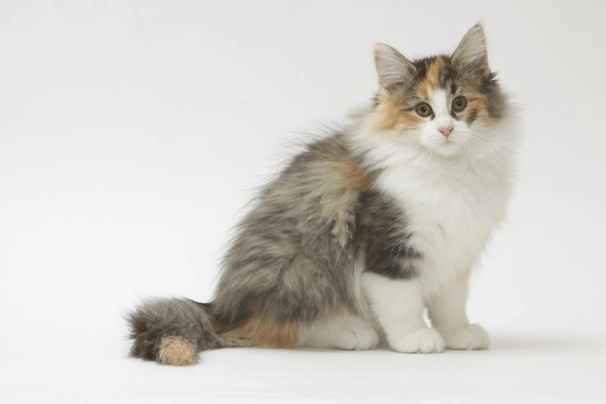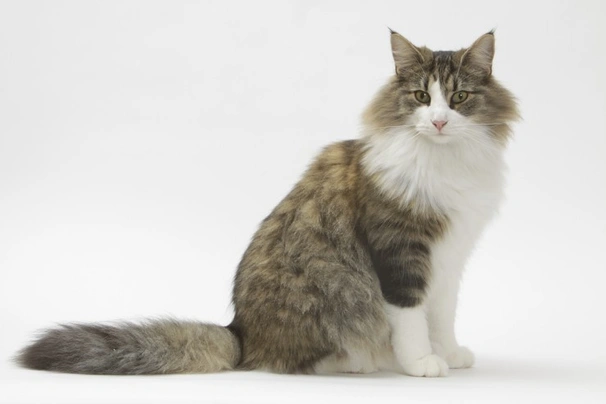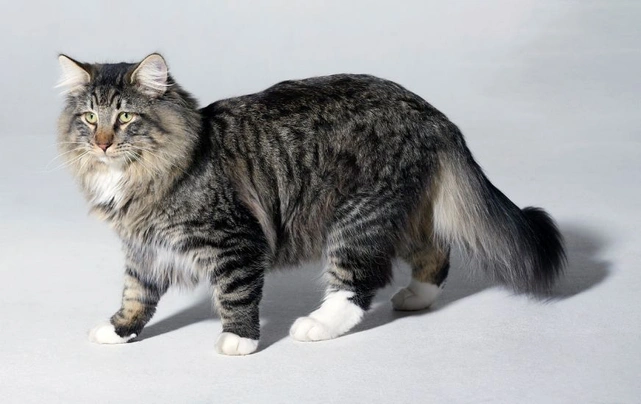Norwegian Forest Cat
Introduction of the Norwegian Forest Cat
The Norwegian Forest Cat is known to have a charming personality that matches their stunning looks. They have been around for hundreds of years and always been highly prized in their native Norway for being a hardy natural breed capable of surviving harsh climates and cold temperatures. They are large cats that take a long time to fully mature which means they remain very kitten-like for a number of years. The Wegie as they affectionately nicknamed has found a big fan base not only in their native land but in many other countries too thanks to their stunning looks and kind gentle natures.
History of the Norwegian Forest Cat
The Norwegian Forest Cat is an ancient breed and one that's thought to have travelled with their Viking owners when they sailed the seas. Their job was to control vermin on ships and they earned themselves the reputation of being extremely good ratters. They are a natural breed and although the exact origins of the breed remain unknown there are many legends of similar looking cats having been kept as pets in Scandinavia as far back as the 16th century.
Over the centuries the Wegie remained a highly prized cat in their native Norway where local folklore described them as being "Fairy Cats". Unlike many other breeds the NFC is fond of playing in water and is very capable of catching fish both in streams and lakes which led to many tales being told in ancient times of these extraordinary longhaired cats.
Today the Norwegian Forest Cat is one of the most natural breeds on the planet thanks to the fact they have only been bred through natural selection. They are also known to be one of the most robust breeds with their dense extremely waterproof coats providing them with a tremendous amount of protection against the elements. They have always been popular in their native Norway and other Scandinavian countries although at the beginning of the 20th century their breed numbers were seen to fall dangerously low to the point where the Norwegian Forest Cat nearly vanished altogether.
Fortunately during the 1930s breeders started to save the breed although World War II had an impact on their work. It was not until the 1970s that a breeding programme was established in order to save these charming cats. It was at this time that the Norwegian Forest Cat became Norway's national feline having been awarded royal recognition by King Olaf. Today the NFC remains a popular companion and family pet thanks to their kind and gentle natures.
Appearance of the Norwegian Forest Cat
The Norwegian Forest Cat is a large feline and one that boasts being a natural hunter. They have extremely water resistant semi-long coats with a very dense undercoat that helps cats cope with the harsher colder conditions often seen in their native Norway. Their coats are a lot denser during the cooler winter months but quite a bit shorter and less thick in the summertime.
They have large heads that are triangular shaped and when seen in profile a cat's nose is straight and long. Their eyes are large and almond shaped being set obliquely at an angle with cats always having a kind gentle expression in them. Ears are large being wider at the base and arching forwards which gives them a very similar look to that of a Maine Coon. Their ears are extremely well furnished which adds to their wild look. They have strong robust bodies and powerful legs with tidy rounded feet. Tails are long and well covered in hair that flows when cats move.
When it comes to their coat the Norwegian Forest Cat boasts having a semi-long top coat and a dense close lying undercoat that offers them a tremendous amount of protection from the elements. They come in all colours with the exception of the following under the GCCF breed standard:
- Chocolate
- Lilac
- Cinnamon
- Fawn
- Siamese
Temperament of the Norwegian Forest Cat
The Norwegian Forest Cat boasts having a sweet kind and gentle nature that matches their stunning looks. They mature slowly which can take up to five years which means they retain many of their kitten-like traits for that much longer than many other breeds. They are intelligent and thrive on being around people. As such they are best suited to households where at least one person stays at home when everyone else is out of the house. They form strong ties with their families but unlike many other breeds the Norwegian Forest Cat does not mind being left on their own as long as it is not for too long.
They tend to be a little shy around people they don't know but once they get to know a person they are much more relaxed around them. They are not overly talkative and have quiet voices however NFCs are always quick to let an owner know when it's meal time when they can be a lot more vocal albeit quietly.
They enjoy being involved in everything that goes on in their environment and being natural hunters Wegies love being allowed to explore the great outdoors. As such they are the perfect choice for people who live in the country where it is safe to let a cat roam outside. They also love to climb up high and for such large cats they are remarkably agile and able to reach great heights. Once up on a perch the Norwegian Forest Cat loves to look down on things below.
Intelligence / Trainability of the Norwegian Forest Cat
As previously mentioned the Norwegian Forest Cat is known to be a highly intelligent cat and one that adapts well to their environment. They learn things quickly and enjoy playing interactive games which includes things like "fetch". Being so smart it's important for NFCs to have lots of mental stimulation and as such they are best suited to people who live in a country environment where it is safer for a cat to roam around in the great outdoors so they can indulge their passion for hunting.
Children and other
Norwegian Forest Cats with their outgoing affectionate and gentle personalities are the perfect choice for families with children and this includes toddlers. They are quick on their feet and therefore know when to get out of the reach of smaller children when they get too boisterous or loud. However care has to be taken when very young children are around cats and any interaction should always be well supervised to make sure things stay nice and calm. With this said younger children need to be taught how to behave around cats and when to leave them alone.
They also get on well with dogs especially if they have grown up together in the same household. However care has to be taken when introducing a NFC to dogs they don't already know just in case the dog does not get on with their feline counterparts. NFCs are incredibly social by nature and have been known to get on with larger pet birds and even some smaller animals. However it's always wiser to keep a close eye on any cat when they are around smaller pets just in case bearing in mind that Wegies are natural hunters.
Health of the Norwegian Forest Cat
The average life expectancy of a Norwegian Forest Cat is between 14 and 16 years when properly cared for and fed an appropriate good quality diet to suit their ages.
The Norwegian Forest Cat is known to be a healthy and robust breed thanks to careful selective breeding and as such they are not predisposed to suffering from the hereditary health issues that often affect many other breeds. One condition that might affect the breed is:
- Pyruvate kinase deficiency - breeders should have stud cats DNA tested
Caring for the Norwegian Forest Cat
As with any other breed NFCs need to be groomed on a regular basis to make sure their coats and skin are kept in top condition. On top of this cats need to be fed good quality food that meets all their nutritional needs throughout their lives which is especially true of kittens and older cats.
Grooming of the Norwegian Forest Cat
Norwegian Forest Cats boast having semi-long top coats and thicker close lying undercoats. However they are low maintenance on the grooming front. A twice weekly brush is all it takes to remove dead hair and to prevent hair from tangling. Like other breeds they tend to shed quite heavily in the Spring and then again in the Autumn when more frequent brushing is usually necessary to keep on top of things.
It's also important to check a cat's ears on a regular basis and to clean them when necessary. If too much wax is allowed to build up it can lead to a painful infection which can be hard to clear up. In short prevention is often easier than cure with ear infections. Cats often suffer from ear mites which can be a real problem which is why it's so important to check their ears on a regular basis.
Exercise of the Norwegian Forest Cat
The Norwegian Forest Cat is a gentle playful cat and one that enjoys playing interactive games like "fetch". They also enjoy being able to roam around in the great outdoors bearing in mind they are renowned for being extremely good natural hunters. However cats should only be allowed outside when it is safe for them to do so.
Cats kept as indoor pets need to be given lots of things to do and places to hide when they want to bearing in mind that an NFC loves to climb up high so they can perch and look down on the world below them. They also need to have lots of places they can snuggle up for a snooze when the mood takes them because if there is one thing the Wegie really enjoys doing it’s napping throughout the day.
Feeding of the Norwegian Forest Cat
If you get a NFC kitten from a breeder they would give you a feeding schedule and it's important to stick to the same routine feeding the same kitten food to avoid any tummy upsets. You can change a kitten's diet but this needs to be done very gradually always making sure they don't develop any digestive upsets and if they do it's best to put them back on their original diet and to discuss things with the vet before attempting to change it again.
Older cats are not known to be fussy eaters but this does not mean they can be given a lower quality diet. It's best to feed a mature cat several times a day making sure it's good quality food that meets all their nutritional requirements which is especially important as cats get older. It's also essential to keep an eye on a cat's weight because if they start to put on too much it can have a serious impact on their overall health and wellbeing. Like all other breeds Wegies need to have free access to fresh clean water at all times.
Norwegian Forest Cat price
If you are looking to buy a Norwegian Forest Cat you would need to pay upwards of £250 for a well-bred pedigree kitten. The cost of insuring a male 3-year-old Norwegian Forest Cat in northern England would be £15.06 a month for basic cover but for a lifetime policy this would set you back £25.17 a month (quote as of Sept 2016). When insurance companies calculate a pet's premium they factor in several things which includes where you live in the UK a cat's age and whether or not they have been neutered or spayed among other things.
When it comes to food costs you need to buy the best quality food whether wet or dry making sure it suits the different stages of a cat’s life. This would set you back between £20 - £25 a month. On top of all of this you need to factor in veterinary costs if you want to share your home with an NFC and this includes their initial vaccinations their annual boosters the cost of neutering or spaying a cat when the time is right and their yearly health checks all of which quickly adds up to over £600 a year.
As a rough guide the average cost to keep and care for a Norwegian Forest Cat would be between £40 to £60 a month depending on the level of insurance cover you opt to buy for your cat but this does not include the initial cost of buying a well-bred kitten.

Beautiful Tri Female Cat
£150
Norwegian x Ragdoll Kittens
£350
